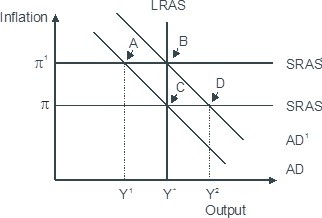Based on the figure below. Starting from long-run equilibrium at point C, a tax cut that increases aggregate demand from AD to AD1 will lead to a short-run equilibrium at point ________ and eventually to a long-run equilibrium at point ________, if left to self-correcting tendencies. 
A. D; C
B. B; C
C. B; A
D. D; B
Answer: D
You might also like to view...
If national income increases by $20 million and consumption increases by $5 million, the marginal propensity is consume is
What will be an ideal response?
An easy money policy will cause the dollar to
A. depreciate and will increase American net exports. B. depreciate and will decrease American net exports. C. appreciate and will increase American net exports. D. appreciate and will decrease American net exports.
Consider an industry that is in long-run equilibrium. An increase in demand leads to a decrease in the price of the good. We know that this is
A) a decreasing-cost industry. B) a constant cost industry. C) an increasing-cost industry. D) not a competitive industry.
Assume that Bulgaria has a comparative advantage in producing sandals and Finland imports sandals from Bulgaria. We can conclude that
A) Bulgaria also has an absolute advantage in producing sandals relative to Finland. B) Bulgaria has a lower opportunity cost of producing sandals relative to Finland. C) Finland has an absolute disadvantage in producing sandals relative to Bulgaria. D) Labor costs are higher for sandal producers in Finland than in Bulgaria.